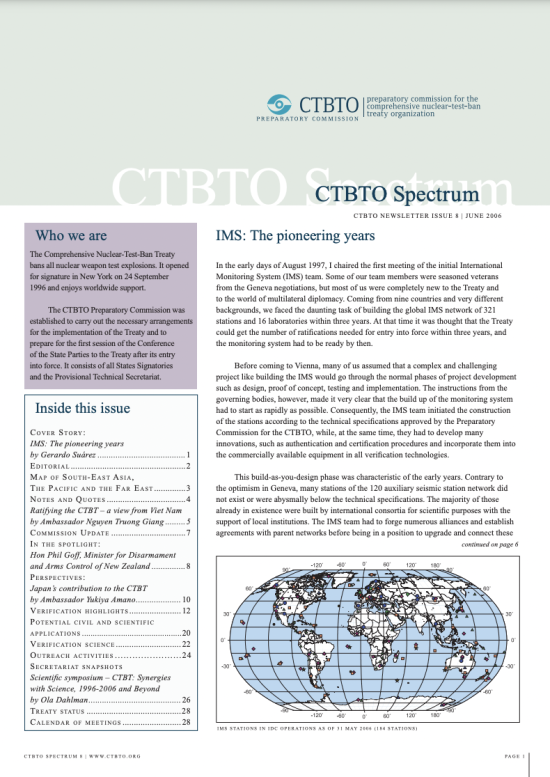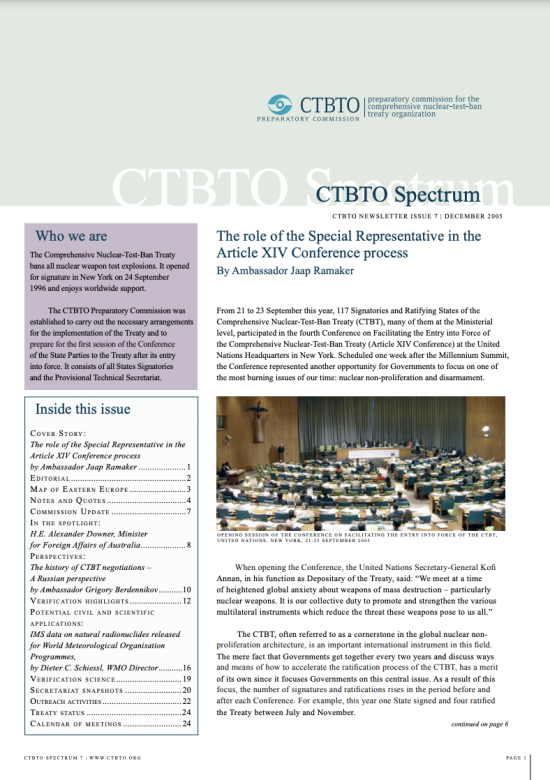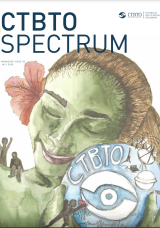
Issue 25: July 2020
This special 25th issue of CTBTO Spectrum, which reappears after a long hiatus, spotlights the essential place of the Comprehensive Nuclear-Test-Ban Treaty (CTBT) within the nuclear non-proliferation and disarmament framework in the run-up to the 10th Review Conference of the Treaty on the Non-Proliferation of Nuclear Weapons (NPT). It features analytical articles based on interviews with a broad range of experts – many of them members of the CTBTO’s Group of Eminent Persons (GEM).
Key perspectives come from Grigory Berdennikov, former Deputy Minister of Foreign Affairs of the Russian Federation; Sérgio Duarte and Angela Kane, both former UN High Representatives for Disarmament Affairs; Chilean diplomat Hellmut Lagos; Patricia Lewis, International Security Programme Director at Chatham House; and Bruno Tertrais, deputy director of the Fondation pour la recherche stratégique (FRS).
Other contributions include a view by founding CTBTO Youth Group (CYG) member Sarah Bidgood on the challenges, risks and opportunities for the CTBT in the final chapter of the 2020 NPT Review Cycle; a close look at the CYG and its inter-generational dialogue with the GEM; a testament to the tragic legacy of nuclear testing by Togzhan Kassenova; and the story of restoring Senegal’s auxiliary seismic station by station operator Mapathé Ndiaye.

Issue 24: September 2015
This issue has been published to coincide with the Ninth Article XIV Conference on 29 September 2015 at UN headquarters in New York, United States, presided over by the Foreign Ministers of Japan and Kazakhstan, Fumio Kishida and Erlan Idrissov. They explain how their countries’ eagerness to see an end to all nuclear testing is rooted in experiencing the horrific effects of nuclear weapons explosions. Other contributors include Federica Mogherini, the European Union’s High Representative for Foreign Affairs and Security Policy, on why the Iran nuclear agreement bodes well for the Comprehensive Nuclear-Test-Ban Treaty (CTBT), and Angela Kane, former UN High Representative for Disarmament Affairs, who recommends progress on the CTBT’s entry into force as an antidote to “disarmament malaise”.
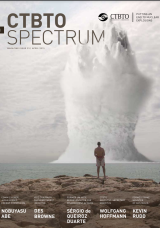
Issue 23: April 2015
This issue of Spectrum contains a number of high-calibre political and verification-related articles, including contributions by the Commissioner of the Japan Atomic Energy Commission and former UN Under-Secretary-General for Disarmament Affairs, Nobuyasu Abe; the Vice Chairman of the Nuclear Threat Initiative and former UK Defence Secretary, Des Browne; the former UN High Representative for Disarmament Affairs, Sérgio Duarte; the CTBTO’s first Executive Secretary, Wolfgang Hoffmann; and former Australian Prime Minister Kevin Rudd.
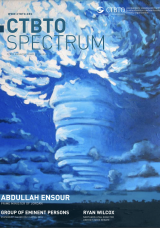
Issue 22: August 2014
In the 22nd issue of Spectrum, Prime Minister Abdullah Ensour of Jordan describes his country’s longstanding support for the Comprehensive Nuclear-Test-Ban Treaty (CTBT), including Jordan’s decision to host the Integrated Field Exercise 2014 (IFE14). Other features include a joint statement by the Group of Eminent Persons (GEM) outlining strategic approaches and modes of action designed to promote the CTBT’s entry into force, and a contribution by Ryan Wilcox, the Northern Utah Director with the U.S. Senate, who opposed his country’s ratification of the CTBT in 1999 but argues that there is now a strong case to justify ratification.
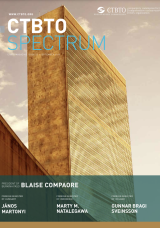
Issue 21: September 2013
This issue features the President of Burkina Faso, Blaise Compaoré, who became the first head of state to address the CTBTO Preparatory Commission at its 40th Session on 13 June 2013. Compaoré shares his vision for a world without nuclear weapons, calling on those remaining States that have not yet signed or ratified the CTBT to do so. The Ministers for Foreign Affairs of Hungary, János Martonyi, and Indonesia, Marty M. Natalegawa, explain why the CTBT’s entry into force is of paramount importance. Iceland’s Minister for Foreign Affairs, Gunnar Bragi Sveinsson, argues that a fully ratified and implemented CTBT is indispensable to help tackle the threat of terrorists acquiring nuclear weapons. This issue also features excerpts of keynote addresses made at the CTBT: Science and Technology 2013 Conference in Vienna, including by the former head of the International Atomic Energy Agency, Hans Blix; the former U.S. Under Secretary of State for Arms Control and International Security Affairs, Ellen Tauscher; the former Director of the Los Alamos National Laboratory, Siegfried Hecker; and the Director for Strategic Affairs in the French Ministry of Defence, Michel Miraillet.
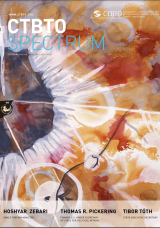
Issue 20: July 2013
In this 20th issue, the Foreign Minister of Iraq, Hoshyar Zebari, reports on the steps taken by the Iraqi parliament towards ratification of the Comprehensive Nuclear-Test-Ban Treaty (CTBT) and the importance Iraq attaches to promoting the Treaty’s entry into force. Ambassador Thomas Pickering, who helped the Kennedy administration draft the Partial Test Ban Treaty, describes why the case for ratification of the CTBT by the United States is stronger than ever. Zia Mian from Princeton University focuses on the role of civil society in South Asia in advocating nuclear disarmament. Columbia University’s Paul Richards explains the seismic findings of the nuclear test announced by North Korea on 12 February; we also elaborate on the radionuclide findings almost two months later.
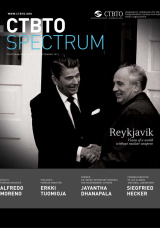
Issue 19: September 2012
In this 19th issue, the Foreign Ministers of Chile and Finland, Alfredo Moreno and Erkki Toumioja, make a strong political pitch for the Treaty and highlight the contribution of CTBT verification data for disaster mitigation. They are joined by two prominent South Asian thinkers: former UN Under-Secretary-General for Disarmament Affairs Jayantha Dhanapala, and Hindustan Times Foreign Editor Pramit Pal Chaudhuri. Nuclear physicist Siegfried Hecker explains why nuclear armed States stand to gain more than they lose from CTBT ratification and Tatsujiro Suzuki, Vice Chairman of the Japan Atomic Energy Commission, provides an invaluable insight into the Fukushima accident.
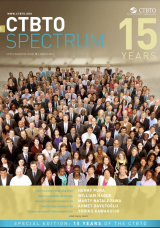
Issue 18: March 2012
In this special 15th anniversary issue of Spectrum and video, a number of former and current staff share some of their personal memories of the journey since March 1997 when the CTBTO began its operations in Vienna. In the words of the first Executive Secretary of the CTBTO, Wolfgang Hoffmann: “We were a very small group of people with a huge task.”
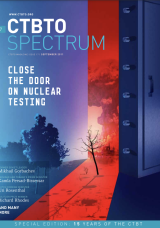
Issue 17: September 2011
In this 17th issue of Spectrum, the former leader of the Soviet Union, Mikhail Gorbachev, calls for a total ban on nuclear testing, saying we should not be content with the current virtual moratorium “because commitments that are not legally binding can easily be violated.” He urges the countries that must still ratify the CTBT to do so in order for the Treaty to enter into force. The Prime Minister of Trinidad and Tobago, Kamla Persad-Bissessar, states that “the CTBT stands as a beacon, lighting the path towards a peaceful world, free from nuclear explosions, whether for military or for peaceful purposes.”
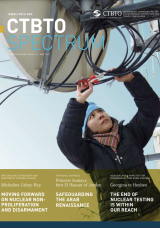
Issue 16: May 2011
In this 16th issue of Spectrum, Princess Sumaya bint El Hassan of Jordan underlines the importance of focusing on the nexus between nuclear safety and nuclear security. She also outlines a proposal to establish sub-National Data Centres at several science universities in Jordan “to increase the use of invaluable IMS data to aid scientific research in fields as diverse as seismology, geology, the environment and ICT,” and her desire for the establishment of a Regional Data Centre in her country to help expand Treaty acceptance in the region. Three analysts from the International Data Centre (IDC), geophysicist Marcela Villarroel, seismologist Jane Gore, and physicist Carla Pires, provide unique insights into one of the CTBTO’s core activities – analyzing the data transmitted by the IMS to the CTBTO headquarters in Vienna.
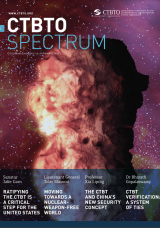
Issue 15: November 2010
In this issue of Spectrum, former U.S. Republican Senator Jake Garn of Utah urges the United States to provide the leadership needed to stop the proliferation of nuclear weapons by permanently ending nuclear weapons testing and ratifying the CTBT. Talat Masood, former Secretary for Defence Production in the Ministry of Defence, Pakistan, outlines the near term and long term developments that will influence the nuclear landscape. Bharath Gopalaswamy, formerly of the Indian Space Research Organization and now at the Stockholm International Peace Research Institute (SIPRI), highlights the benefits of CTBTO membership and points out that States that have not signed the Treaty are at a disadvantage since they do not have access to verification data. Xia Liping from Tongji University in China explains why CTBT ratification is in China’s strategic interests. And Michel Nambobona, the Director General of the National Data Centre in the Central African Republic, outlines how he helped to secure CTBT ratification by his nation.
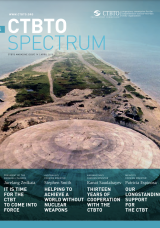
Issue 14: April 2010
In this 14th issue of Spectrum, President Jurelang Zedkaia of the Marshall Islands describes the legacy of nuclear weapon testing on his country and urges full global acceptance and ratification of the Treaty. Kanat Saudabayev, the Foreign Minister of Kazakhstan, summarizes the 13 years of cooperation between Kazakhstan and the CTBTO and his country’s strong support for the CTBT. The Foreign Ministers of Australia, Stephen Smith, and Mexico, Patricia Espinosa Cantellano, reiterate the unwavering commitment of their respective countries to a CTBT in force. Ambassador Stephen Ledogar, the U.S. chief negotiator of the CTBT, expands on a number of key issues from the Treaty’s negotiations that continue to be relevant for today’s debate. On-site inspection expert John Walker highlights the main lessons of the Integrated Field Exercise 2008 in Kazakhstan, the CTBTO’s largest ever on-site inspection exercise.
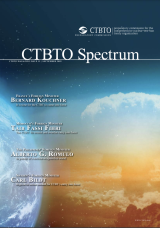
Issue 13: September 2009
In this 13th issue of Spectrum, four foreign ministers explain why the CTBT is important to their countries: Bernard Kouchner of France and his Moroccan counterpart, Taieb Fassi Fihri, who will be jointly presiding over the Article XIV conference; Alberto Romulo of the Philippines; and Carl Bildt of Sweden, the country currently holding the EU Presidency. Chinese nuclear arms control expert Shen Dingli explains why China should ratify the CTBT. James Goodby, former U.S. diplomat and specialist on nuclear non-proliferation and security, puts the CTBT into the wider context of nuclear non-proliferation. Physicist and verification expert David Hafemeister presents a detailed analysis on the CTBT’s verifiability. Sidney Drell, physicist and longtime adviser to the U.S. government and the nuclear weapons laboratories, reflects on the Stockpile Stewardship Program, an important factor for the U.S. discussions on CTBT ratification, and Japan’s North-West Pacific Tsunami Information Center explains how it profits from International Monitoring System (IMS) data.
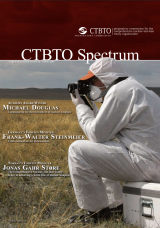
Issue 12: April 2009
CTBTO Spectrum 12 highlights the crucial role that the CTBT plays in the nuclear non-proliferation and disarmament regime. It includes an interview with the Academy Award-winning actor and UN Messenger for Peace, Michael Douglas, as well as articles by the German Foreign Minister, Frank-Walter Steinmeier, and the Norwegian Foreign Minister, Jonas Gahr Støre. Their contributions are complemented by articles from Deepti Choubey of the Nuclear Nonproliferation Program at the Carnegie Endowment for International Peace, and Raymond Jeanloz of the University of California, Berkeley.
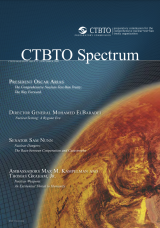
Issue 11: September 2008
This 11th issue of CTBTO Spectrum focuses on the role of the CTBT in the wider non-proliferation and disarmament context. Contributors include President Oscar Arias of Costa Rica, IAEA Director General Mohamed ElBaradei, former US Senator Sam Nunn, US Ambassadors Max Kampelman and Tom Graham, and Daryl Kimball, Executive Director of the Arms Control Association. There are also feature articles on the Integrated Field Exercise 2008 for on-site inspections, the challenges of establishing monitoring stations in Antarctica, the ongoing International Scientific Studies project to assess the readiness and capability of the CTBT to detect nuclear explosions worldwide, and the cooperation between the CTBTO and the World Meteorological Organization.
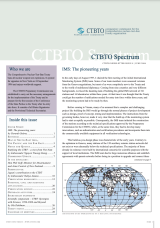
Issue 10: August 2007
This special issue of CTBTO Spectrum focuses on the political importance of early entry into force leading up to the Article XIV Conference and the many challenges arising when building a global verification system. Contributors include United Nations Secretary-General Mr Ban Ki-moon and Dr Hans Blix, former Chairman of the Weapons of Mass Destruction Commission, who give their views on the significance of the CTBT. Their contributions are complemented by a special feature analysis by Dr Rebecca Johnson, Director of the Acronym Institute.
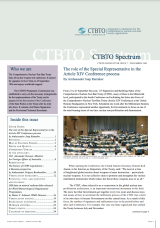
Issue 9: January 2007
This issue of CTBTO Spectrum looks at the many interactions between the NAWE region and the CTBT, at the anniversary activities marking the adoption of the Treaty ten years ago, as well as at the achievements of the CTBTO Preparatory Commission and future challenges. Several hundred participants listened to presentations of world-renowned scientists in the first scientific symposium organized by the PTS, which was held from 31 August to 1 September 2006 at the Hofburg in Vienna. Delegations and scientists engaged in a multi-disciplinary exchange of ideas and explored synergies between the global scientific community and the CTBTO Preparatory Commission.

Issue 8: July 2006
Besides providing an outlook on the scientific symposium by Ola Dahlman, former Working Group B Chairman, this issue of CTBTO Spectrum looks at the many interactions between the South-East Asia, the Pacifi c and the Far East (SEAPFE) region and the CTBT. An interview with the Minister of Disarmament and Arms Control of New Zealand, Hon Phil Goff, focuses on the eminent role of New Zealand in nuclear disarmament and non-proliferation. Ambassador Yukiya Amano of Japan looks at his country’s contribution to the Treaty, and the Ambassador of Vietnam, H.E. Nguyen Truong Giang, gives his personal view on Viet Nam’s decision to ratify the CTBT as the 34th Annex 2 State.

Issue 7: December 2005
This 7th issue of CTBTO Spectrum takes a close look at the Article XIV process and the results of the 2005 Article XIV Conference. Two eminent supporters of the Treaty provided contributions in this context: An interview with Alexander Downer, Minister of Foreign Affairs of Australia and President of the 2005 Article XIV Conference, recaptures, inter alia, his own personal efforts and the special historic role of Australia regarding the CTBT. The cover story by Ambassador Jaap Ramaker provides new insights into his role in promoting the entry into force of the Treaty as the Special Representative of the Ratifier States. The Eastern European region, the main focus of this issue, is a particularly good example of the continuing and robust support for the Treaty, with all 22 Member States having signed and 19 having ratified it.
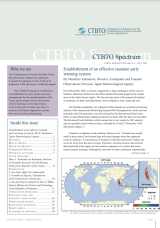
Issue 6: July 2005
The African region provides the overarching theme for this issue of CTBTO Spectrum, and offers a particularly good example for the ever increasing numbers of signatures and ratifications: Of those States who signed and ratified the Treaty in 2004, 75 and 66 percent respectively were from the African region.
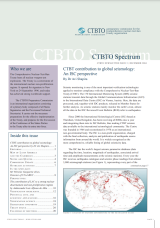
Issue 5: December 2004
This 5th issue of CTBTO Spectrum focuses on the Latin America and the Caribbean (LAC) geographical region and the CTBT. It is the first issue in a series which will be covering all six Treaty-defined regions. The LAC region has always played an important role in contributing towards ensuring the entry into force and universality of the CTBT. When the Treaty opened for signature in 1996, 21 LAC States signed it. In the meantime, the number of signatures has increased to 27, with 20 LAC countries having also ratified the CTBT as of 6 December 2004.
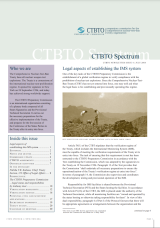
Issue 4: July 2004
This 4th issue of CTBTO Spectrum focuses on the legal aspects of building the verification regime. It sets out to examine the essential role played by facility agreements and other legal arrangements in placing the provisional operation and maintenance of the IMS on a secure legal foundation. An interview with Palitha Kohona, Chief of the Treaty Section of the Office of Legal Affairs at the United Nations in New York, a special feature article by Anthony Aust, former Legal Counsellor of the United Kingdom Foreign Office, and the cover story by Peter Hulsroj, PTS Legal Advisor, give further insights into the unique legal status of the Preparatory Commission and its verification regime.
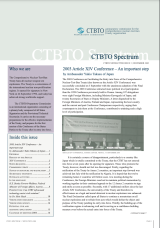
Issue 3: December 2003
This 3rd issue of CTBTO Spectrum looks at the results of the Article XIV Conference. The cover story by Ambassador Yukio Takasu provides a Member State’s view of the Conference. As an overarching theme, this issue focuses on the benefits of signing the Treaty, both political and those deriving from the potential civil and scientific applications of the verification technologies. An interview with Minister Benita Ferrero-Waldner, and a special feature article by Hein Haak, a Dutch infrasound expert, concentrate on this theme.
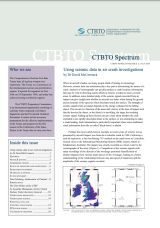
Issue 2: July 2003
This 2nd issue of CTBTO Spectrum looks at the ‘mechanisms’ of Conferences on Facilitating the Entry into Force of the CTBT, focusing in particular on the upcoming Conference, which will take place in Vienna from 3 to 5 September this year. An interview with Ambassador Tom Grönberg, who is chairing the preparatory process of the 2003 Conference, and a special feature article by the former United Nations Under-Secretary General Jayantha Dhanapala, concentrate on this theme. In addition, the cover story by David McCormack, a Canadian seismologist, gives an example of the potential benefits of civil and scientific applications of the CTBT verification technologies.
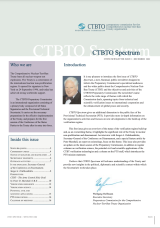
Issue 1: December 2002
This first issue gives an overview of the status of the verification regime build-up and, as an overarching theme, it highlights the significant role of the Treaty in nuclear non-proliferation and disarmament. An interview with Sergei A. Ordzhonikidze, Secretary-General of the Conference on Disarmament, and a special feature article by Peter Marshall, an expert on seismology, focus on this theme.
